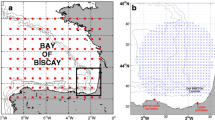Abstract
The aim of this work is to obtain an index for predicting the probability of occurrence of zonda event at surface level from sounding data at Mendoza city, Argentine. To accomplish this goal, surface zonda wind events were previously found with an objective classification method (OCM) only considering the surface station values. Once obtained the dates and the onset time of each event, the prior closest sounding for each event was taken to realize a principal component analysis (PCA) that is used to identify the leading patterns of the vertical structure of the atmosphere previously to a zonda wind event. These components were used to construct the index model. For the PCA an entry matrix of temperature (T) and dew point temperature (Td) anomalies for the standard levels between 850 and 300 hPa was build. The analysis yielded six significant components with a 94 % of the variance explained and the leading patterns of favorable weather conditions for the development of the phenomenon were obtained. A zonda/non-zonda indicator c can be estimated by a logistic multiple regressions depending on the PCA component loadings, determining a zonda probability index \( \widehat{c} \) calculable from T and Td profiles and it depends on the climatological features of the region. The index showed 74.7 % efficiency. The same analysis was performed by adding surface values of T and Td from Mendoza Aero station increasing the index efficiency to 87.8 %. The results revealed four significantly correlated PCs with a major improvement in differentiating zonda cases and a reducing of the uncertainty interval.









Similar content being viewed by others
References
Araneo DC, Simonelli SC, Norte FA, Viale M, Santos JR (2011) Caracterización de sondeos estivales del norte de Mendoza mediante el análisis de componentes principales y obtención de un índice de convección. Meteorológica 36(1):31–47
Deming J, Chaohua D, Ruili H, Ronghui C, (2008) Impact assessment of additional predictors to the retrieval of atmospheric profiles from infrared radiances. Proceedings of SPIE-The International Society for Optical Engineering, Art. n° 71520D
Duarte ML (1993) Temporal variations of the vertical profile of temperatures of Argentina. Int J Climatol 13:437–445
Dürr B (2008) Automatisiertes verfahren zur bestimmung von foehn in alpentaelern. Bundesamt für Meteorologie und Klimatologie, MeteoSchweiz
Durran D R (2003) Downslope winds. Encycl Atmos Sci, pp 644–650
Gutermann T (1970) “Vergleichende Untersuchungen zur Fönh aufigkeit im Rheintal zwischen Chur und Bodensee.” Scientific Reports 18, Schweizerische Meteorologische Zentralanstalt, Zurich
Lattin J, Carroll JD, Green PE, (2003) Analyzing Multivariate Data. Duxbury Applied Series, Thompson Brooks/Cole. 556 págs
Norte FA (2015) Understanding and forecasting Zonda wind (Andean foehn) in Argentina: a review. Atmospheric and Climate Sciences 5(03):163. doi:10.4236/acs.2015.53012
Norte FA (1999) A hybrid expert system for the prediction of extreme meteorological situations such as the Zonda wind in the Cuyo Region, Western Argentina. Southern Hemisphere paleo- and neoclimates. In: Smolka PP (ed) Key sites, methods data and models. University of Muenster, Springer–Verlag, Berlin/Heidelberg 1999, pp. 172–173
Norte, F, M. Silva, (1995): “Predicting severe versus moderate Zonda wind in Argentina“. 14th conference on weather analysis and forecasting Dallas, Texas, E.E.U.U. Pag. 128–129.
Norte FA, Seluchi ME (1993) Objective methods for the zonda forecasting using information from surface and height. Preprints of the fourth international conference on the southern hemisphere meteorology and oceanography, Hobart, Australia, American Meteorological Society, March 29–April 2, 1993, pp 128–129
Norte FA (1988) Características del viento Zonda en la Región de Cuyo. PhD thesis, Buenos Aires University, pp 255
Otero F, Norte FA (2015) Métodos de clasificación y climatología del viento Zonda en San Juan. Geoacta 40(1):45–53
Smith WL, Woolf HM (1976) The use of eigenvectors of statistical covariance matrices for interpreting satellite sounding radiometer observations. J Atmos Sci 33:1127–1140
Wang J, Cole HL, Carlson DJ (2001) Water vapor variability in the tropical western Pacific from 20-year radiosonde data. Adv Atmos Sci 18(N° 5):752–766
Author information
Authors and Affiliations
Corresponding author
Rights and permissions
About this article
Cite this article
Otero, F., Norte, F. & Araneo, D. A probability index for surface zonda wind occurrence at Mendoza city through vertical sounding principal components analysis. Theor Appl Climatol 131, 213–225 (2018). https://doi.org/10.1007/s00704-016-1983-7
Received:
Accepted:
Published:
Issue Date:
DOI: https://doi.org/10.1007/s00704-016-1983-7




